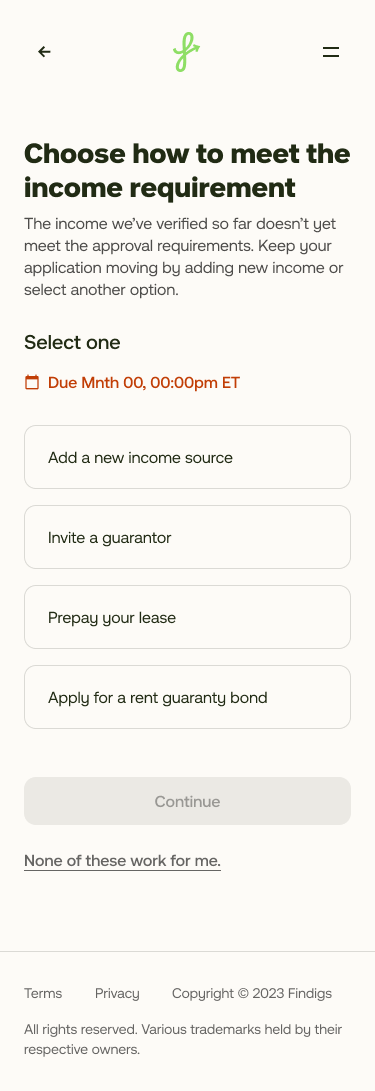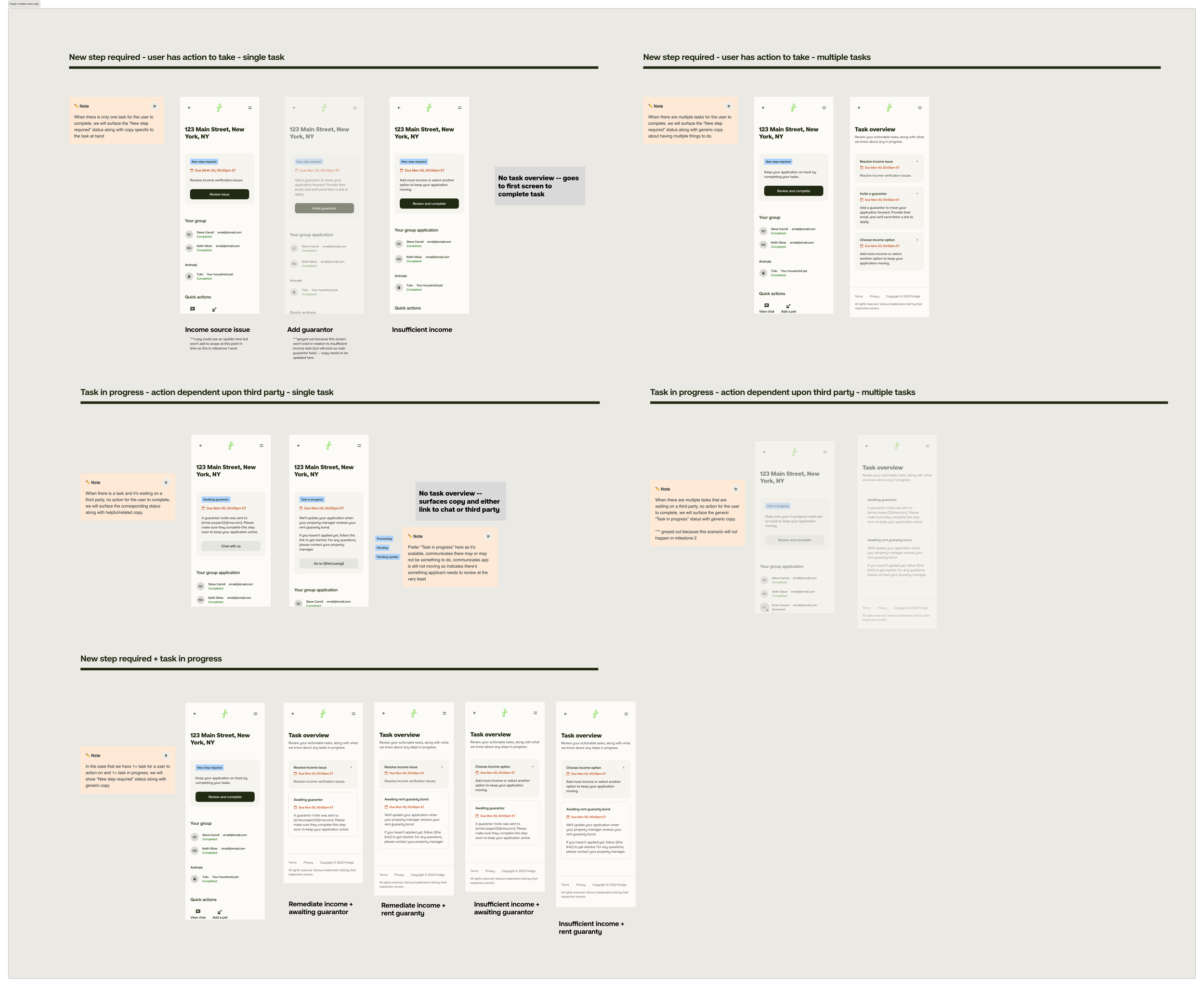Findigs Task Service
My role:
Senior Writer/Content Designer
The context
At Findigs, income verification was a major friction point in the rental application process. Users often didn’t know what documents were needed, how to upload them correctly, or why they were being asked for additional steps. This led to stalled applications, support requests, and user frustration, especially in complex cases involving multiple applicants, guarantors, or AI-flagged documentation issues.
The team was building a new task service system with a centralized dashboard where users could clearly see and complete required actions. I was brought in to lead content design for several task service flows, with a focus on:
Designing content for multiple income verification scenarios (add income, invite guarantor, prepay lease, apply for bond)
Building and refining AI prompts to generate error messages, fallback content, and system explanations
Creating clarity and trust in moments of uncertainty, especially where AI models made decisions behind the scenes
My process
1) Discovery & mapping
Met with product, design, and engineering leads to understand the blend of AI-driven logic and human review the DecisionAssist product runs on
Audited existing flows to identify where users got stuck or confused (e.g., uploading the wrong doc type, misunderstanding what income types counted)
Mapped out legal and UX requirements for the four different user paths:
add a new income source
invite a guarantor
prepay lease
apply for a rent guaranty bond
Prepay lease screens
2) AI-aided prompting & microcopy iteration
Goal: Use generative AI to explore microcopy directions faster, especially for error states, fallback messages, and complex user scenarios while maintaining clarity, tone, and compliance.
What I did:
Wrote custom prompts to generate draft copy for hard-to-write moments like document rejection errors, fallback messaging for unsupported income types, and loading states.
Reviewed and refined AI output, ensuring it aligned with Findigs’ brand voice and legal constraints. I often started with raw AI-generated copy and rewrote for clarity, tone, and specificity. Or vice versa!
Used prompting to generate content variants, which helped accelerate decision-making in cross-functional reviews (e.g. presenting 2–3 directions for error messages).
Evaluated where AI broke down (e.g. tone drift, confusing phrasing, over-assumption of user intent) and adjusted prompts or rewrote outputs accordingly.
Documented useful prompts and outcomes informally, which helped shape content decisions and supported knowledge-sharing across the team.
Apply for rent guaranty bond flow
3) Content & flow design
Goal: Build clear, task-oriented UI content across all paths — so users always know what’s expected of them, and how to complete their application.
What I did:
Structured content across the entire income verification journey: from first task entry through to submission and resolution.
Designed for edge cases, like group applications (where one person’s action blocks others), multiple income sources, and duplicate document submissions.
Wrote full UI copy, including:
Headings and task summaries
Step-by-step task instructions
Error and success messages
Confirmations and decision support
Improved clarity by renaming internal labels (e.g. “step” → “task”) and aligning language across engineering and design so user-facing terminology was consistent.
Embedded legal requirements into the UX — like showing required disclaimers or file type guidance only when relevant.
4) Review, governance & handoff
Goal: Ensure the system could be maintained and scaled with consistent voice, AI oversight, and clear collaboration across teams.
What I did:
Delivered content and design specs to engineering with my product design partner, including logic for when different messages should appear.
Worked with legal to validate copy across all user flows, especially around document requirements and third-party approvals.
Partnered with design to QA content in final screens, ensuring everything read naturally in context and aligned with the voice we set during testing.
The last part of this project I really got to work on is the dashboard. We needed to design a task overview page that users could access from their dashboards to view and complete their tasks. The tasks, of course, differ from each other and depend on various factors, so I set out to create a logic pattern for when we surface what copy or experience. I split the use cases into the following, creating flows for each:
New step required - user has action to take - single task
New step required - user has action to take - multiple tasks
New step required - action dependent upon third party - single task
New step required - action dependent upon third party - multiple tasks
**Note: I inherited “step” terminology instead of task when I began the project, and right before getting laid off, I was working on a brief to change all instances of “new step required” to “new task required” to simplify and make the experience consistent across all task service flows.
Task overview dashboard
What changed
Delivered end-to-end content and flow logic for all income-related tasks
Created a reusable AI prompt framework for microcopy, now used across other Findigs teams
Standardized terminology, tone, and structure across flows for consistency
Surface-level UX clarity improvements now backed by more systemic alignment in how Findigs approaches AI-driven flows
Shifted internal thinking toward content governance and AI oversight as part of product development
Why this work mattered
This project wasn’t just about getting users to finish a task. It was about building a content system that supports DecisionAssist at scale, ensures trust and transparency, and reduces the friction that causes applications to stall. My work directly helped:
Accelerate flow completion (expected to reduce stalled applications by 15–20%)
Improve user trust and confidence at sensitive moments (financial verification, group decisions)
Establish internal content governance that has broader implications across product
Bridge AI behavior and real-user needs, making the invisible backend logic understandable, navigable, and humane






